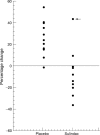Rectal epithelial apoptosis in familial adenomatous polyposis patients treated with sulindac
- PMID: 10562579
- PMCID: PMC1727764
- DOI: 10.1136/gut.45.6.822
Rectal epithelial apoptosis in familial adenomatous polyposis patients treated with sulindac
Abstract
Background: Sulindac regresses colorectal adenomas in patients with familial adenomatous polyposis (FAP), although the mechanism of polyp regression is unclear.
Aims: To determine whether differences occur in alteration of rectal epithelial apoptotic index and expression of apoptosis related proteins in FAP patients treated with sulindac compared with placebo.
Patients: Twenty one FAP patients; 12 had not undergone colectomy.
Methods: Patients with FAP were treated with sulindac 150 mg orally twice a day for three months (n=10) or placebo (n=11). Colorectal polyp number was determined and biopsies of the normal rectal mucosa were performed before and after three months of treatment. Response to treatment and alteration of the apoptotic ratio (index in base of crypt divided by index in surface epithelium) were evaluated. Bcl-2, bax, p21/WAF-1, and p53 proteins were assessed semiquantitatively by immunohistochemistry.
Results: Significant decreases in polyp number and in the apoptotic ratio were seen in patients treated with sulindac compared with controls. The mean percentage change in polyp number from baseline was -46% in the sulindac group and +13% in the placebo group (p=0.005). Mean percentage change in the apoptotic ratio was -8% and +25% in the sulindac and placebo treated patients, respectively (p=0.004). No differences in expression or compartmentalisation of apoptosis related proteins were noted between treatment groups.
Conclusions: Sulindac regression of colorectal adenomas is accompanied by alteration of the rectal epithelial apoptotic ratio with relative increase in apoptosis in surface cells compared with the deeper crypt. The utility of the apoptotic ratio as an intermediate biomarker for colorectal tumorigenesis deserves further study.
Figures



Comment in
-
Cryptic messages in FAP.Gut. 1999 Dec;45(6):795-6. doi: 10.1136/gut.45.6.795. Gut. 1999. PMID: 10562573 Free PMC article. No abstract available.
References
Publication types
MeSH terms
Substances
Grants and funding
LinkOut - more resources
Full Text Sources
Research Materials
Miscellaneous
